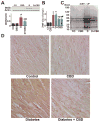Cannabidiol attenuates cardiac dysfunction, oxidative stress, fibrosis, and inflammatory and cell death signaling pathways in diabetic cardiomyopathy
- PMID: 21144973
- PMCID: PMC3026637
- DOI: 10.1016/j.jacc.2010.07.033
Cannabidiol attenuates cardiac dysfunction, oxidative stress, fibrosis, and inflammatory and cell death signaling pathways in diabetic cardiomyopathy
Abstract
Objectives: In this study, we have investigated the effects of cannabidiol (CBD) on myocardial dysfunction, inflammation, oxidative/nitrative stress, cell death, and interrelated signaling pathways, using a mouse model of type I diabetic cardiomyopathy and primary human cardiomyocytes exposed to high glucose.
Background: Cannabidiol, the most abundant nonpsychoactive constituent of Cannabis sativa (marijuana) plant, exerts anti-inflammatory effects in various disease models and alleviates pain and spasticity associated with multiple sclerosis in humans.
Methods: Left ventricular function was measured by the pressure-volume system. Oxidative stress, cell death, and fibrosis markers were evaluated by molecular biology/biochemical techniques, electron spin resonance spectroscopy, and flow cytometry.
Results: Diabetic cardiomyopathy was characterized by declined diastolic and systolic myocardial performance associated with increased oxidative-nitrative stress, nuclear factor-κB and mitogen-activated protein kinase (c-Jun N-terminal kinase, p-38, p38α) activation, enhanced expression of adhesion molecules (intercellular adhesion molecule-1, vascular cell adhesion molecule-1), tumor necrosis factor-α, markers of fibrosis (transforming growth factor-β, connective tissue growth factor, fibronectin, collagen-1, matrix metalloproteinase-2 and -9), enhanced cell death (caspase 3/7 and poly[adenosine diphosphate-ribose] polymerase activity, chromatin fragmentation, and terminal deoxynucleotidyl transferase dUTP nick end labeling), and diminished Akt phosphorylation. Remarkably, CBD attenuated myocardial dysfunction, cardiac fibrosis, oxidative/nitrative stress, inflammation, cell death, and interrelated signaling pathways. Furthermore, CBD also attenuated the high glucose-induced increased reactive oxygen species generation, nuclear factor-κB activation, and cell death in primary human cardiomyocytes.
Conclusions: Collectively, these results coupled with the excellent safety and tolerability profile of CBD in humans, strongly suggest that it may have great therapeutic potential in the treatment of diabetic complications, and perhaps other cardiovascular disorders, by attenuating oxidative/nitrative stress, inflammation, cell death and fibrosis.
Copyright © 2010 American College of Cardiology Foundation. Published by Elsevier Inc. All rights reserved.
Conflict of interest statement
No conflicts to disclose.
Figures









References
-
- Fein FS. Diabetic cardiomyopathy. Diabetes Care. 1990;13:1169–79. - PubMed
-
- Regan TJ, Ahmed S, Haider B, Moschos C, Weisse A. Diabetic cardiomyopathy: experimental and clinical observations. N J Med. 1994;91:776–8. - PubMed
-
- Asbun J, Villarreal FJ. The pathogenesis of myocardial fibrosis in the setting of diabetic cardiomyopathy. J Am Coll Cardiol. 2006;47:693–700. - PubMed
-
- Kajstura J, Fiordaliso F, Andreoli AM, et al. IGF-1 overexpression inhibits the development of diabetic cardiomyopathy and angiotensin II-mediated oxidative stress. Diabetes. 2001;50:1414–24. - PubMed
Publication types
MeSH terms
Substances
Grants and funding
LinkOut - more resources
Full Text Sources
Other Literature Sources
Medical
Research Materials
Miscellaneous

